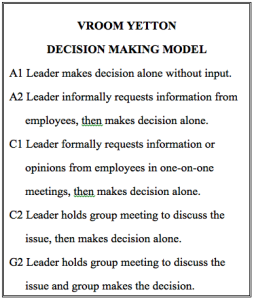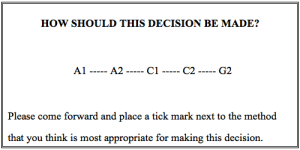Making decisions is a key activity in today’s participative meetings. Once a problem has been defined, analyzed, and the potential solutions brainstormed, decisions must be made. How can a meeting group or organization improve their quality of decision making and do so with a minimum amount of stress? My next blogs provide ten techniques to ensure that the best decisions are made, the decisions are understood and agreed upon, and that when multiple decisions are made, they are prioritized for the most effective implementation.
The ten techniques to make decisions include:
- Vroom Yetton Decision Making Model
- Multivoting
- Negative Voting
- Dots
- 100 Votes
- Nominal Prioritization
- 3 For/3 Against
- Criteria Matrix
- Impact and Changeability Analysis
- Business Case
This blog highlights Technique 1: Vroom Yetton Decision Making Model.
“I’m all for participation, but sometimes it doesn’t seem logical that every decision should be made as group. It’s overkill and sometimes the pay off is marginal. Is there a technique that will help our organization to effectively determine the most appropriate person or group to make each decision we are confronted with?
#1: Vroom Yetton Decision Making Model
What is Vroom Yetton Decision Making Model?
The Vroom Yetton Decision Making Model is a technique for determining how much participation is needed or desired to make a specific decision. Even in this age of participation, not every decision should be made participatively. The most appropriate level of decision making depends on the specific issue and situation.
The Vroom Yetton Decision Making Model offers a spectrum of decision making choices that range from authoritarian to consultative to group participative. In most cases, the group leader consciously or subconsciously uses the Vroom Yetton Decision Making Model to decide individually how to make a given decision. It is wise for the facilitator to agree the decision making authority of the group with the meeting owner/group leader in advance of the meeting. This clarity helps the facilitator design the workshop appropriately and avoid any confusion or uncomfortable situations during the meeting itself.
Alternatively, the following instructions illustrate how a meeting group, for example, a project team, can use this model to determine the most appropriate level of participation for any decision facing them.
When to Use Vroom Yetton Decision Making Model
- When the appropriate level of participation in making a specific decision is not clear
- When you are not sure if a specific issue is worthy of meeting time
How to Use Vroom Yetton Decision Making Model
1. Articulate the decision or decisions to be made.
2. Outline the Vroom Yetton Decision Making Model to your meeting group. Vroom and Yetton, the creators of this model, identified five distinct procedures for making decisions. These methods are categorized as illustrated below. In the below figure, “A” stands for Authoritarian, “C” for Consultative, and “G” for Group:
3. Lead a group discussion on how to address the decision/s under consideration based on the choices displayed above.
4. After the discussion, ask the participants to vote for what they each consider to be the best choice within the model for the specific decision/s to be made. Have them make tick marks on a prepared chart similar to the one below.
OPTION: Provide each participant with a pre-prepared voting ballot so that each participant can vote privately.
OPTION: Vote by e-mail.
5. Proceed accordingly. If the entire meeting group is not involved in making the decision/s, agree a communication plan to keep participants informed.
In Summary:
The Vroom Yetton Decision Making Model is a technique for deciding what level of participation is most appropriate when making a given decision.
1. Articulate the decision or decisions to be made.
2. Introduce the Vroom Yetton Decision Making Model.
3. Lead a group discussion on how the decision should be made.
4. Ask the participants to vote for what they each consider to be the best choice within the model for the given decision to be made.
5. Proceed accordingly.
Source:
Victor Vroom and Philip Yetton, Leadership and Decision-Making. (University of Pittsburgh Press, 1973).
———————-
NOTE: If you would like to receive e-mail notification when I post additional techniques, please sign up through this link. http://eepurl.com/KILan You may unsubscribe at any time.
You will find my book Mission Critical Meetings: 81 Practical Facilitation Techniques on Amazon

